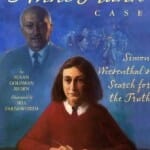 Days after listening to Ela Weissberger’s talk at the Boulder Public Library, I continued to think about her words. I questioned when the retelling of a Holocaust event becomes an accepted fact and when does it fall under historic scrutiny?
Days after listening to Ela Weissberger’s talk at the Boulder Public Library, I continued to think about her words. I questioned when the retelling of a Holocaust event becomes an accepted fact and when does it fall under historic scrutiny?
Ela was dismayed when a notable Holocaust expert questioned one of her recollections. This historian was unable to locate documented evidence that supported Ela’s assertion that Hitler had visited her public school. She mentioned this event on page 7 of The Cat with the Yellow Star: Coming of Age in Terezin.
Ela’s words were examined. She was understandably annoyed. Who likes to be questioned, especially when you feel your recollections are accurate? Fortunately, Ela was able to locate a photograph that confirmed her words. For other Holocaust survivors, it may be either too late or not that simple.
Should Ela’s words have been questioned? Was the doubt raised by the historian any different than the accusations made by Holocaust deniers?
Simon Wiesenthal (1908-2005) spent most of his life in search of Holocaust evidence. He is best known for his efforts to bring over 1100 Nazi war criminals to justice. Until I read The Anne Frank Case: Simon Wiesenthal’s Search for the Truth, I was not aware of his early efforts to disprove Holocaust deniers. In her picture book, Susan Goldman Rubin describes Simon’s frustration in 1958 when he witnessed Austrians claiming that the Anne Frank story was untrue. These individuals rudely interrupted a public performance of The Diary of Anne Frank by shouting and dropping leaflets from the balcony.
One of these individuals, a neo-Nazi teenager, challenged Simon to find proof that Anne Frank had existed and authored her famous diary. Simon was committed to locating the Gestapo officer who arrested Anne Frank. For years, Simon pieced together different leads and followed up on any that seemed promising. Dead ends were inevitable since there was minimal information available. In 1963, Simon found the officer who could substantiate Anne Frank’s existence and arrest. All along Simon knew that Anne’s story was true, but yet he was compelled to put an end to the persistent questioning.
It is one thing to question the validity of an event or a chain of events. It is totally different to absolutely deny or pretend that something did not happen at all. History books are filled with questionable accounts that may or may not be true. Some can be substantiated while other words and events remain uncertain. Historians are responsible for writing about the most likely scenario while others are free to inquire or disagree with their findings.
However, when people intentionally try to distort recorded history by injecting their bias and prejudices, history can end up being corrupted. All efforts need to be made by academics and the public to prevent this from happening.
Leave a Reply
You must be logged in to post a comment.